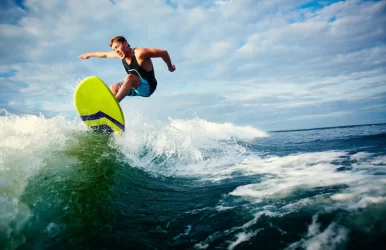Beginners Guide To Surfing: What You Need To Know
BY Abdul Aziz MondalApr 27, 2022
Surfing is one of the best ways to enjoy spending time in the sea. Learning how to surf may not be as easy as you may think. It will take some time, regular practice, and commitment to perfect your technique. So, you will need to know the basics first, learn how to keep yourself safe and dedicate your time to the waves. Learning how to surf can be fun. So, let's learn about the basics of surfing. What to Wear in the Water While Surfing? Before you hit the water, you need to choose the right wetsuit. There are plenty of wetsuits to choose from, in all shapes, sizing, for summer and winter use, for both cold water and warm water. First, think about where you want to surf – is it somewhere warm or cold? Then, think about how much money you want to spend on your wetsuit. Some wetsuits offer a lot of comforts, while others offer a lot of mobility. The thickness of the neoprene is crucial for a wetsuit. It affects the temperature, comfort, and flexibility of the wetsuit. Then you have various types of wetsuits – full suits, long john, top, bottom, and more. So, try to find the best wetsuit that suits your needs. Which Surfboard is Best Learning to Surf? Now that you have something to wear, which type of surfboard should you opt for in the beginning? Longer surfboards are recommended for beginners instead of opting for a shorter surfboard. Short surfboards may look cool, but they lack the volume and length for beginners to catch the waves without more advanced surfing skills. Longboards are easy to ride and paddle and can help you to learn how to ride the waves much easier. There are many surfboards that are shorter than 8ft in length. These surfboards can often be referred to by names like Mini Tanker, Funboard, Fish, Egg, Mini Mal, and Bonzer. Surfboards like these are easy to paddle into smaller waves and swells. How to Catch a Wave and Ride it Catching the wave and riding it is the goal of any surfer. There are seven basic steps that you can take to start. Here are the steps: 1. Practice popping up. You can do this on dry land or on the beach beforehand to develop your technique. Do this by pressing your hands into the ground or board beneath your chest. Try to do this swiftly until you can jump to your feet in one swift movement. Consider Going Through: Top 10 Best Beaches In Florida For Families 2. In the water, paddle out to the lineup of incoming waves. 3. When you see the wave, you would like to catch, turn your surfboard around and point your board toward the shoreline. Lay down and start paddling to gain speed. Try to keep the tip of your board above the water, but not too high. 4. Look behind you to see where the wave is and continue paddling forward. Try to stay not too far in front of the water and not too far outside. Understanding where you need to be to catch a wave may take some time and regular practice to perfect your technique. 5. Keep looking forward and sense where the wave is. When you feel your momentum is increasing, it’s time to stand up. Use the technique you practiced on dry land to transition from laying to standing on the surfboard. 6. Hop in one motion and ride the wave. A moment of hesitation could disrupt your stability. When you manage to stand up on your board and start riding the wave, stay calm, look ahead and watch where your feet are. 7. Keep bending your knees and put more weight on your back foot. Use your arms to balance yourself. Now you are surfing. Final thoughts Training how to surf can be tiring during your first few times. Don't be surprised if you feel tired after the first few sessions. Surfing is a unique physical sport and requires a lot of energy for paddling and balancing the board. But with the right equipment and techniques, you will become a proficient surfer. Read Also: 10 Best Places To Travel In May – Travel Guide 2022 10 Best Places To Travel In April – Travel Guide 2022 10 Best Places To Travel In January – Travel Guide 2022









